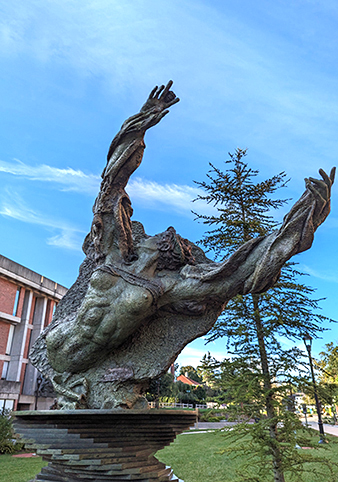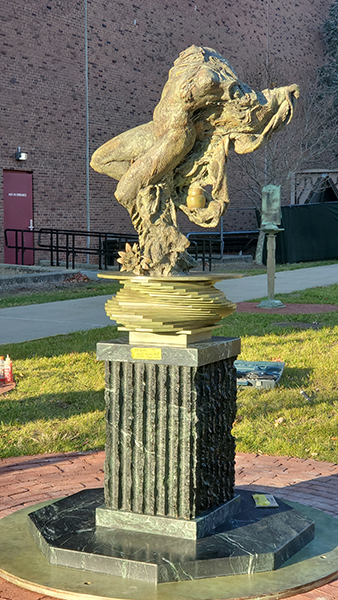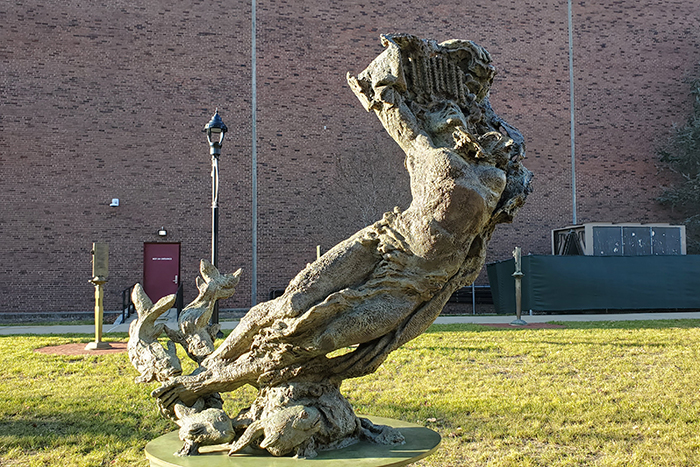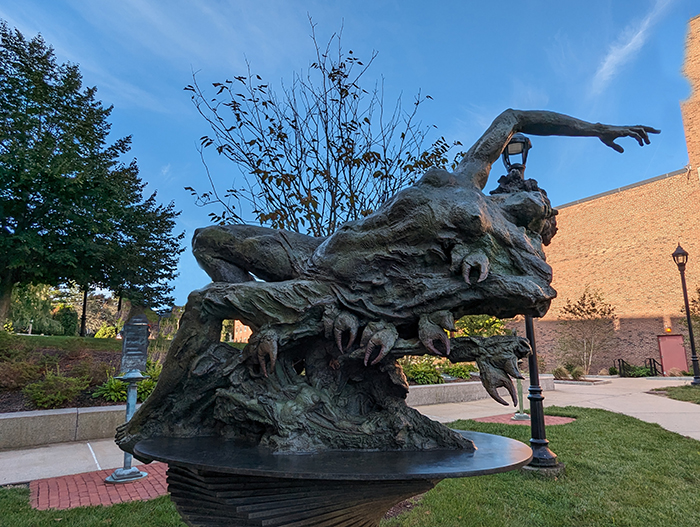
Goddesses of Rivers and Seas
Greg and Fay Wyatt Sculpture Garden
Greg Wyatt’s sculptural compositions that represent these goddesses integrate classical technique with innovative figurization. Each of the four figures in the works are a reminder of the Academic tradition of sculpture: from Ancient Greece and Rome to the Italian Renaissance, the postures, costumes and bodies of these figures beckon to the ancient traditions of historical masters.These particular sculptures, in conjunction with the sculptural representation through the material figurization, represent a connection between ancient and modern worlds. Each of the four goddesses are compositionally outfitted with symbolic image representations of traditional attributes that they are associated with.

In ancient Egyptian mythology, the Nile River was associated with many deities, reflective of the river’s importance to the daily lives of the Eqyptians. Satis, a southern goddess of fertility is the goddess of the Cataracts of the Nile as well as its flooding; Khnum is the god of the source of the Nile. Together, they have a daughter, Anuket . Anuket, Satis, and Khnum form the traid protectors of the Nile River.
Every year, in the fall, the Nile River will flood as a result of the monsoon season. This flooding occurred in three stages: inundation, growth and harvest. The flooding nourishes the fields with rich salt and mineral deposits; Anuket’s name means “embrace,” possibly as an original reference to the embrace of the waters of inundation. During the floods, people would throw coins, gold, jewelry and precious gifts into the river, in thanks for the life-giving water and returning benefits derived from the wealth provided by her fertillity. Anuket is referred to by several different tiltes including “Lady of Embracing”, “Nourisher of the Fields” and “She Who Shoots Forth,” in reference to the shooting forth of the river waters during monsoon season.
Anuket is generally depicted as having the body of a woman with the head of the gazelle, or a woman with a headdress made of reeds or ostrich feathers or sometimes simply just a gazelle---which, like arrows, are associated with the goddess for their quick-moving similarities to the river’s flow. Her headdress is often seen with uraeus, the cobra of the Lower Egypt. Anuket personifies the life-giving powers of the river and was worshipped as a protective deity during childbirth, and was depicted suckling the pharaoh during the New Kingdom.
Ganga is the divine personification of the sacred Ganges River. In Hinduism, she and the river are worshipped as one. It is believed that the waters of the Ganges river are a channel for liberation and purification, both supporting life and fertile agriculture, and purifying and cleansing pollution of the body and the spirit. It can be understood that Ganga’s divine body is the Ganges River, and that the Ganges’ spirit takes up the mantle of Ganga. She is commonly interpreted as Mother Ganges.
She has the powers of compassion and comfort in the form of blessings to her many earthly children. Her motherly care can lead to a place that is free from sorrow, fear, old age and death. The goddess is also said to be aware of everyone’s deepest fears and desires. Ganga takes these feelings upon herself, leaving the individual purified and strengthened. Everyday, millions bathe in and drink from the river, and pray on its banks. Using the water for washing, bathing and cooking is a way to make sure one can receive Ganga’s blessings and grace. Ganga’s waters are understood to be the life giving, immortal liquid (amrta) of mother’s milk.
Ganga’s heavenly descent to earth (avatarana) is described in various ways in Hindu mythology. Many ways are associated with the three most important male gods: Brahma, Vishnu and Shiva. In one account, Ganga descends to Earth and uses Shiva to break hear fall. As she falls through his hair, she becomes divided into many streams, each flowing to a different part of the earth. This splitting had the spiritual purpose of cleaning and purifying the souls of the sixtythousand sons of King Sagara; the splitting of Ganga physically manifests as the rivers. She and the Ganges River continue to be understood and worshiped as a sacred place to honor the ashes of the dead and to guarantee a safe journey to the ancestral realm.

The goddess Mazu is a guardian deity of seafarers originally worshipped on the coastal communities of mainland China. To this day, there are over 1,000 temples established in Mazu’s honor, particularly on the island of Taiwan. Her merciful image is a blessing for safe sea-travel— thus, pilgrimages in her honor are made yearly ,primarily by fishermen.

Mazu is a deified version of the purportedly historical figure, Lin Mo-niang. During her lifetime in the 10th-Century, Lin Mo was recognized for her abilities as a clairvoyant, healer, and profound religious scholar who comprehended an expansive grasp of Buddhist and Confucius texts at a young age. Her most famous achievement came at the age of 16 when her father and her brothers, far away at sea on a fishing voyage, were caught by a tremendous storm. It is said that she slipped into a trance just as the storm was at its fiercest. After she regained consciousness, her father and her brothers returned home safely, swearing that Lin Mo had projected herself out into the ocean to save them. An alternative legend says that she saved her brothers, but because she was disturbed during her trance she let go of her father, who then drowned. According to another version, she swam out to sea and searched for her father, but drowned and was washed ashore in the Matsu Islands—for whom Mazu the goddess is named.
In religious depictions, Mazu is represented with noble clothing—adorned with beads and jewels, she holds a ceremonial hu tablet and wears a mian guan headdress, which were traditional to Chinese rulers, nobles, ministers and high officials. In her mythology, she is renown for defeating and hiring two demons, who often flank her altars: Qianliyan, “Eyes that See a Thousand Leagues,” and Shunfeng’er, “Ears that Hear the Wind.” In addition to her skills as a healer and shaman, Mazu possessed physical prowess in swimming and martial abilities. In some legends, she subdued these demons using a silk scarf with magical properties.
Salacia is a goddess of salt water who presides over the depths of the ocean. Rooted in ancient Roman mythology, Salacia represents the divine feminine of the oceans; she is the personification of the calm and sunlit aspect of the sea in contrast with the masculine storminess of Neptune, her consort.

The god Neptune wanted to marry Salacia, but she was in great awe of her distinguished suitor, and to preserve her virginity, with grace and celerity she managed to glide out of his sight, and hid from him in the Atlantic Ocean. The grieving Neptune sent a dolphin to look for her and persuade the fair nymph to return and share his throne. Salacia agreed to marry Neptune and the King of the Deep was so overjoyed at these good tidings that the dolphin was awarded a place in the heavens, where he now forms a well known constellation Delphinus. S
alacia is represented as a beautiful nymph, crowned with seaweed, either enthroned beside Neptune or driving with him in a pearl shell chariot drawn by dolphins, sea-horses (hippocamps) or other fabulous creatures of the deep, and attended by Tritons and Nereids.She is dressed in queenly robes and has nets in her hair.
As his wife, Salacia bore Neptune three children, the most celebrated being Triton, whose body was half man and half fish.